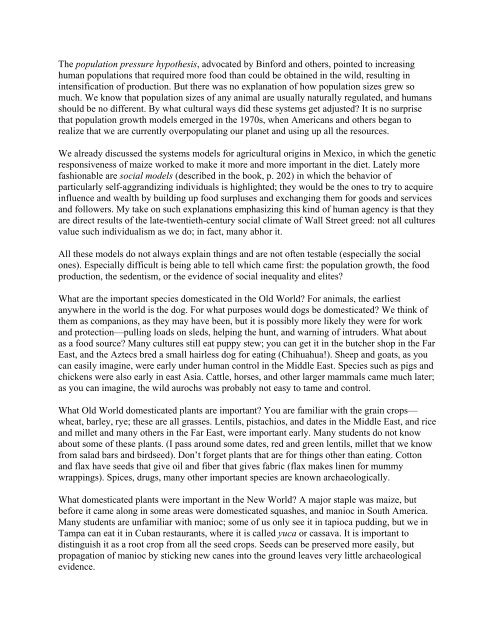INTRODUCTION TO ARCHAEOLOGY Nancy White - Touro Institute
INTRODUCTION TO ARCHAEOLOGY Nancy White - Touro Institute
INTRODUCTION TO ARCHAEOLOGY Nancy White - Touro Institute
Create successful ePaper yourself
Turn your PDF publications into a flip-book with our unique Google optimized e-Paper software.
The population pressure hypothesis, advocated by Binford and others, pointed to increasing<br />
human populations that required more food than could be obtained in the wild, resulting in<br />
intensification of production. But there was no explanation of how population sizes grew so<br />
much. We know that population sizes of any animal are usually naturally regulated, and humans<br />
should be no different. By what cultural ways did these systems get adjusted? It is no surprise<br />
that population growth models emerged in the 1970s, when Americans and others began to<br />
realize that we are currently overpopulating our planet and using up all the resources.<br />
We already discussed the systems models for agricultural origins in Mexico, in which the genetic<br />
responsiveness of maize worked to make it more and more important in the diet. Lately more<br />
fashionable are social models (described in the book, p. 202) in which the behavior of<br />
particularly self-aggrandizing individuals is highlighted; they would be the ones to try to acquire<br />
influence and wealth by building up food surpluses and exchanging them for goods and services<br />
and followers. My take on such explanations emphasizing this kind of human agency is that they<br />
are direct results of the late-twentieth-century social climate of Wall Street greed: not all cultures<br />
value such individualism as we do; in fact, many abhor it.<br />
All these models do not always explain things and are not often testable (especially the social<br />
ones). Especially difficult is being able to tell which came first: the population growth, the food<br />
production, the sedentism, or the evidence of social inequality and elites?<br />
What are the important species domesticated in the Old World? For animals, the earliest<br />
anywhere in the world is the dog. For what purposes would dogs be domesticated? We think of<br />
them as companions, as they may have been, but it is possibly more likely they were for work<br />
and protection—pulling loads on sleds, helping the hunt, and warning of intruders. What about<br />
as a food source? Many cultures still eat puppy stew; you can get it in the butcher shop in the Far<br />
East, and the Aztecs bred a small hairless dog for eating (Chihuahua!). Sheep and goats, as you<br />
can easily imagine, were early under human control in the Middle East. Species such as pigs and<br />
chickens were also early in east Asia. Cattle, horses, and other larger mammals came much later;<br />
as you can imagine, the wild aurochs was probably not easy to tame and control.<br />
What Old World domesticated plants are important? You are familiar with the grain crops—<br />
wheat, barley, rye; these are all grasses. Lentils, pistachios, and dates in the Middle East, and rice<br />
and millet and many others in the Far East, were important early. Many students do not know<br />
about some of these plants. (I pass around some dates, red and green lentils, millet that we know<br />
from salad bars and birdseed). Don’t forget plants that are for things other than eating. Cotton<br />
and flax have seeds that give oil and fiber that gives fabric (flax makes linen for mummy<br />
wrappings). Spices, drugs, many other important species are known archaeologically.<br />
What domesticated plants were important in the New World? A major staple was maize, but<br />
before it came along in some areas were domesticated squashes, and manioc in South America.<br />
Many students are unfamiliar with manioc; some of us only see it in tapioca pudding, but we in<br />
Tampa can eat it in Cuban restaurants, where it is called yuca or cassava. It is important to<br />
distinguish it as a root crop from all the seed crops. Seeds can be preserved more easily, but<br />
propagation of manioc by sticking new canes into the ground leaves very little archaeological<br />
evidence.
















